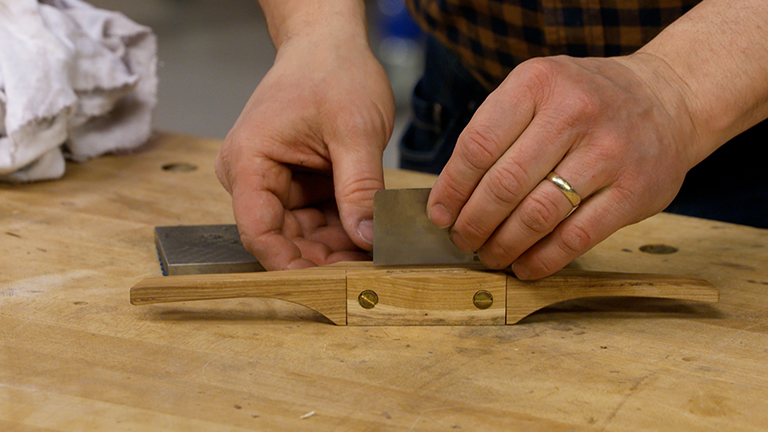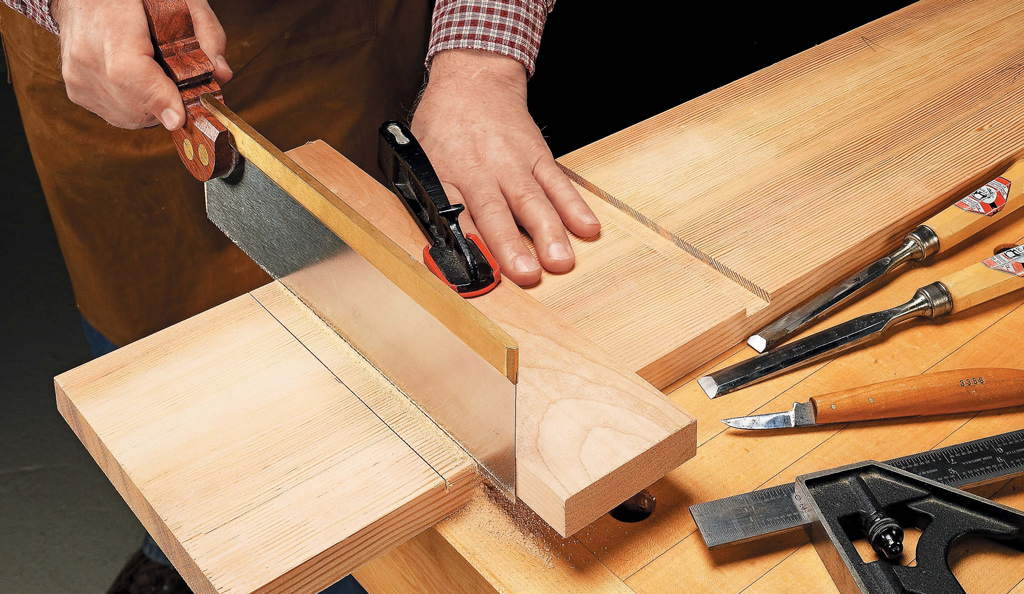
With a shop full of power tools for cutting and shaping wood, it's easy to overlook many traditional hand tools. But most woodworkers agree that developing some skill with a chisel is time well spent. Learning a few, easy-to-master techniques will pay off in better-quality projects.
When you learn to control a chisel accurately, you can shave away small amounts of wood to fine tune the fit of a joint and accomplish a number of other common tasks. Good control starts by developing the proper grip for underhand and overhand use.
OVERHAND GRIP. When making vertical paring cuts, you need to use an overhand grip, as shown in the photo. The idea is to use your body weight in a very controlled way. Holding the handle close to your chest while guiding the blade with the other hand provides control both on the placement of the blade and the pressure on the cut.
The control comes from keeping your elbow close to your body. This body position allows you to keep the handle of the chisel stable, guiding the direction of the blade. It also makes the force you apply on the blade easier to control by simply shifting your weight to lean down on the chisel.

UNDERHAND GRIP. For horizontal paring cuts, an underhand grip is usually the best choice (Figure 1 above). For this grip, rest the handle in your hand with your thumb pointing forward. Once again, your opposite hand provides the control for steering the blade as you use your body to lean into the cut.

OPPOSITE HAND. These two basic grips provide the force, but your opposite hand controls the direction of the cut. Figure 2 shows how good opposite-hand technique allows you to use a mallet with accuracy. In the examples that follow, you'll see even more possibilities.
Using the Bevel
One of the handiest features of a chisel is being able to use the bevel either up or down to make a cut. Once you've learned how to take advantage of the differences in orientation, you'll be able to make precise, shaving cuts without fear of causing tearout on the workpiece.


The drawings above show a couple of common examples. To clean out the bottom of a groove or dado, placing the bevel down against the surface makes it simple to pare away any ridges. This orientation allows plenty of fine control to prevent the blade from digging in.
With the bevel up, you can chisel away a hinge mortise. After establishing a flat spot, the blade will cut everything in the same plane.
Cleaning up a Mortise
An easy way to cut mortises is by drilling a series of overlapping holes at the drill press. Then you can use a chisel to remove the ridges on the sides and ends.
The drawings below show how to guide the chisel to pare away the waste. This technique leaves smooth walls for a better-fitting mortise and a flat glue surface.



I start with a wide chisel on the sides. A wide blade helps keep the surface smooth, with no "steps" between cuts. Take thin shavings, starting at the tips of the ridges and move back until the wall of the mortise is smooth. By controlling the downward pressure with your dominant hand and using your opposite hand to direct the blade, you'll quickly get a feel for it. Pivoting the chisel allows you to make fine paring cuts for a smooth wall.
With the sides cleaned up, switch to a chisel that matches the width of the mortise to square the ends.
Trimming a Tenon
Cutting tenons on the table saw can leave flaws that affect the fit and strength of the finished joint. If the miter gauge or tenoning jig are even slightly out of alignment, the result is often revealed as a small "step" between the cheeks and shoulders. This step can prevent a good fit, since it won't allow the shoulder to seat against the mortised piece. But paring it without damaging the face of the workpiece can be a challenge.

The key is to start with a wide chisel flat on the shoulder of the tenon and pivot the blade into the step (Figure 1). I use an underhand grip to pare away the step. After that, I use a chisel that's a little bit narrower than the thickness of the workpiece to cut toward the tenon to remove the waste. Then, use an overhand grip to slide the blade down the length of the tenon to remove the shaving (Figure 2).

By mastering these basic chisel skills, you're well on your way to better-fitting project parts and higher-quality woodworking.











